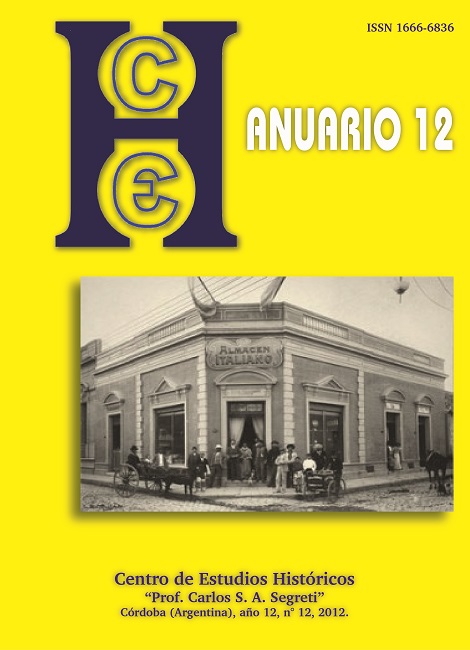Notas sobre el culto de los santos en el Irán preislámico
DOI:
https://doi.org/10.52885/2683-9164.v0.n12.22700Palabras clave:
cristianismo, culto de los mártires, imperio sasánidaResumen
Este trabajo se propone analizar el papel simbólico jugado por el debate en torno a las prácticas funerarias zoroastrianas en la literatura martirológica cristiana del Irán sasánida. Las referencias a la exposición de cadáveres han sido interpretadas como el reflejo de un debate teológico más amplio en el que se enfrentaban dos concepciones antagónicas de la creación y del papel del hombre en ella. Sin embargo, un relevamiento de los testimonios disponibles permite encontrar numerosas contradicciones y desplazamientos que revelan una relación mucho más compleja y fluida entre el registro teológico y el narrativo. En suma, la hagiografía construyó dichos conflictos como manera de establecer barreras interconfesionales en diversos contextos polémicos que, en la práctica, estaban dominados por la ambigüedad.
Descargas
Referencias
BARNES Timothy, “Constantine and the Christians of Persia”, Journal of Roman Studies, 75, 1985.
BROCK Sebastian, “Christians in Sasanian Empire: A Case of Divided Loyalties”, Studies in Church History, 18, 1982.
DE JONG Albert, Traditions of the Magi. Zoroastrianism in Greek and Latin literature, Leiden, Brill, 1997.
DARYAEE Turaj, “The Ideal King in the Sasanian World Ardaxš?r ? P?bag?n or Xusr? An?šag-ruw?n?”, N?me-ye Ir?n-e B?st?n,vol. 3, núm. 1, 2003.
DEBIE? Muriel, “Writing History as ‘Histoires’: the biographical dimension of East Syriac historiography”, PAPACONSTANTINOU Arietta, DEBIE? Muriel, KENNEDY Hugh (eds.), Writing ‘True Stories’ Historians and Hagiographers in the Late Antique and Medieval Near East, París, Brepols, 2010.
DODDS Eric R., Pagan and Christian in an Age of Anxiety, Cambridge, Cambridge University Press, 1965.
HOWARD-JOHNSTON James y HAYWARD Paul Anthony, The Cult of Saints in Late Antiquity and the Middle Ages. Essays on the Contribution of Peter Brown, Oxford, Oxford University Press, 1999.
GARIBOLDI Andrea, Il regno di Xusraw dall’anima immortale: riforme economiche e rivolte sociali nell’Iran sasanide del VI secolo, Milán, Mimesis, 2006.
GIGNOUX Phillipe, “Sur quelques relations entre Chrétiens et mazdéens d’aprés des sources syriaques”, Studia Iranica, vol. 28, 1999.
GUIDI Ignazio (ed.), Chronicum Anonymum, Chronica Minora I. Corpus Scriptorum Christianorum Orientalium, 1-2, Scriptores Syri 1-2, Lovaina, Peeters, 1906-1907.
JOHNSON Aaron, Ethnicity and Argument in Eusebius’ Preaparatio Evangelica,Oxford, Oxford University Press, 2006.
JULLIEN Christelle, “VIe siècle, un Temps de Réformes en Iran. E?chos dans l’Eglise Syro-Orientale?”,Parole de l’Orient,vol. 33, 2008.
KAWERAU Peter (ed.),Die Chronik von Arbela, Corpus Scriptorum Christianorum Orientalium, 467-468, Scriptores Syri, 199-200, Lovaina, Peeters, 1985.
McDONOUGH Scott, “A Question of Faith? Persecution and Political Centralization in the Sasanian Empire of Yazdgard II (438-457 CE.)”, DRAKE Harlod (ed.), Violence, Victims, and Vindication in Late Antiquity,Aldershot, Ashgate, 2006.
McDONOUGH Scott, “Bishops or Bureaucrats?: Christian Clergy and the State in the Middle Sasanian Period”, KENNET Derek y LUFT Paul (eds.), Current Research in Sasanian Archaeology, Art and History: Proceedings of a Conference Held at Durham University, November 3rd and 4th, 2001,Oxford, Archaeopress, 2008.
McDONOUGH Scott, “The Legs of the Throne: Kings, Elites, and Subjects in Sasanian Iran”, ARANSON Johann y RAAFLAUB Kurt (eds.), The Roman Empire in context. Historical and Comparative Perspectives, Chichester, Wiley-Balckwell, 2011.
MARKUS Robert, “How on Earth Could Places Become Holy? Origins of the Christian Idea of Holy Places”, JECS,vol. 2, 1994.
REININK Gerrit, “Tradition and the Formation of the ‘Nestorian’ Identity in Sixth- to Seventh-Century Iraq”, Church History and Religious Culture, vol. 89, 2009.
RIST Josef, “Die Verfolgung der Christen im Spätantiken Sasanidenreich: Ursachen, Verlauf, und Folgen”, Oriens Christianus, vol. 80, 1996.
SAMELLAS Antigone, Death in the Eastern Mediterranean (50-600 A.D.). The Christianization of the East: An interpretation, Studien und Texte zu Antike und Christentum 12, Tübingen, Mohr Siebeck, 2002.
SHAKED Shaul, “Religion in the late Sasanian Period: Eran, Aneran, and other Religious Designations”, Vesta SARKOSH CURTIS y Sarah STEWART (eds.),The Idea of Iran. Vol. 3, The Sasanian Era, N.Y., Tauris, 2008.
STAUSBERG Michael, Die Religion Zarathusthras. Geschichte-Gegenwart-rituale, Colonia, Kohlhammer, 2002.
VAN ROMPAY Lucas, “Impetuous Martyrs? The Situation of the Persian Christians in the Last Years of Yazdgard I (419-421)”, LAMBERGIST Mathijs (ed.), Martyrium in Multidisciplinary Perspective. Memorial Louis Reekmans, Lovaina, Peeters, 1995.
VERNANT Jean Pierre, “Inde, Mésopotamie, Grèce: trois idéologies de la mort”, Jean Pierre VERNANT, L’individu, la mort, l’amour, París, Gallimard, 1996.
WALKER Joel, The Legend of Mar Qardagh. Narrative and Christian Heroism in Late Antique Iraq, Berkeley, University of California Press, 2006; “The Legacy of Mesopotamia in Late Antique Iraq: The Christian Martyr Shrine at Melqi (Neo-Assyrian Milqia)”, Aram, vol. 18-19, 2006-2007.
WIESSNER Gernot, Zur Märtyrer-überlieferung aus der Christenverfolgung Schapurs II, Göttingen, Vandenhoeck & Ruprecht, 1967.
Descargas
Publicado
Número
Sección
Licencia
Aquellos autores/as que tengan publicaciones con esta revista, aceptan los términos siguientes:
- Los autores/as conservarán sus derechos de autor y garantizarán a la revista el derecho de primera publicación de su obra, el cuál estará simultáneamente sujeto a una Licencia de reconocimiento de Creative Commons. Se puede compartir, copiar, distribuir, ejecutar y comunicar públicamente la obra, siempre que: a) se cite la autoría y la fuente original de su publicación (revista, editorial y URL de la obra); b) no se use para fines comerciales; c) no se altere, transforme o genere una obra derivada a partir de esta obra.
- Los autores/as podrán adoptar otros acuerdos de licencia no exclusiva de distribución de la versión de la obra publicada (p. ej.: depositarla en un archivo telemático institucional o publicarla en un volumen monográfico) siempre que se indique la publicación inicial en esta revista.
- Se permite y recomienda a los autores/as difundir su obra a través de Internet (p. ej.: en archivos telemáticos institucionales o en su página web) después del proceso de publicación, lo cual puede producir intercambios interesantes y aumentar las citas de la obra publicada. (Véase El efecto del acceso abierto).









